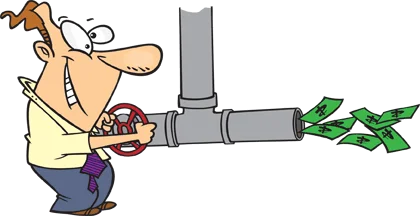Balance Sheet
Financial Statements

Balance Sheet
The balance sheet is derived from our accounting equation and is a formal representation of our equation
Assets = Liabilities + Owner's Equity.
If you recall, in an earlier lesson we learned that this equation is also called the Balance Sheet Equation.
The categories and format of the Balance Sheet are based on what are called Generally Accepted Accounting Principles (GAAP). These principles are the rules established so that every business prepares their financial statements the same way.
What makes up a Balance Sheet ?
Assets
Formal Definition:The properties used in the operation or investment activities of a business.
Informal Definition:All the good stuff a business has (anything with value). The goodies.
Additional Explanation:
The good stuff includes tangible and intangible stuff. Tangible stuff you can physically see and touch such as vehicles, equipment and buildings. Intangible stuff is like pieces of paper (sales invoices) representing loans to your customers where they promise to pay you later for your services or product. Examples of assets that many individuals have are cars, houses, boats, furniture, TV’s, and appliances. Some examples of business type assets are cash, accounts receivable, notes receivable, inventory, land, and equipment.
Assets are listed based on how quickly they can be converted into cash which is called liquidity. In other words, they’re ranked. The asset most easily converted into cash is listed first followed by the next easiest and so on. Of course since cash is already cash it’s the first asset listed.
Liabilities
Formal Definition:Claims by creditors to the property (assets) of a business until they are paid.
Informal Definition:Other’s claims to the business’s stuff. Amounts the business owes to others.
Additional Explanation:
Usually one of a business’s biggest liabilities (hopefully they are not past due) is to suppliers where they have bought goods and services and charged them. This is similar to us going out and buying a TV and charging it on our credit card. Our credit card bill is a liability. Another good personal example is a home mortgage. Very few people actually own their own home. The bank has a claim against the home which is called a mortgage. This mortgage is another example of a personal liability. Some examples of business liabilities are accounts payable, notes payable, and mortgages payable.
Liabilities are listed in the order of how soon they have to be paid. In other words, the liabilities that need to be paid first are also listed first.
Owner’s Equity (Capital)
Formal Definition:The owner’s rights to the property (assets) of the business; also called proprietorship and net worth.
Informal Definition:What the business owes the owner. The good stuff left for the owner assuming all liabilities (amounts owed) have been paid.
Additional Explanation:
Owner’s Equity represents the owner’s claim to the good stuff (assets). Most people are familiar
with the term equity because it is so often used with lenders wanting to loan individuals money based on their home equity. Home equity can be thought of as the amount of money an owner would receive if he/she sold their house and paid off any mortgage (loan) on the property.
Owner’s equity (or net worth or capital ) is increased by money or property contributed and any profits earned and decreased by owner withdrawals and losses.
All Balance Sheets contain the same categories of assets, liabilities, and owner’s equity.
If you look below at our Balance Sheet for ABC Mowing you can readily see that there are three main sections, assets, liabilities, and owner’s equity just like the accounting equation.
The major sections of a balance sheet are the heading, the assets,the liabilities, and the owner’s equity. The heading contains the name of the company, the title of the statement, and the date of the statement.
| ABC Mowing | |||
| Balance Sheet | |||
| As Of December 31,xxxx | |||
| Assets | Liabilities | ||
| Cash | $5,080 | Accounts Payable | $2,060 |
| Accounts Receivable | 1,600 | Notes Payable | 10,000 |
| Office Supplies | 100 | ||
| Mowing Equipment | 12,500 | Total Liabilities | $12,060 |
| Owner's Equity | |||
| ABC Capital | 7,220 | ||
| Total Assets | $19,280 | Total Liabilities & Equity | $19,280 |
This layout is called the Account Form. In this form the major categories are presented side by side.
Another layout sometimes used is called the Report Form. In this form the major categories are stacked on top of each other.
An example of the Report Form follows.
| ABC Mowing | ||
| Balance Sheet | ||
| As Of December 31,xxxx | ||
| Assets | ||
| Cash | $5,080 | |
| Accounts Receivable | 1,600 | |
| Office Supplies | 100 | |
| Mowing Equipment | 12,500 | |
| Total Assets | $19,280 | |
| Liabilities | ||
| Accounts Payable | $2,060 | |
| Note Payable-Bank | 10,000 | |
| Total Liabilities | $12,060 | |
| Owner's Equity | ||
| ABC Capital | $7,220 | |
| Total Liabilities & Equity | $19,280 | |
The Balance Sheets presented for our mowing guys above is a simple representation of a Balance Sheet. Normally, a business prepares what is called a Classified Balance Sheet with many categories.
A Classified Balance for our mowing guys is presented below.
| ABC Mowing | |||
| Classified Balance Sheet | |||
| As Of December 31,xxxx | |||
| Assets | Liabilities | ||
| Current Assets | Current Liabilities | ||
| Cash | $5,080 | Accounts Payable | $2,060 |
| Accounts Receivable | 1,600 | Note Payable-Current Portion | 2,500 |
| Office Supplies | 100 | Total Current Liabilities | 4,560 |
| Total Current assets | $6,780 | ||
| Fixed Assets | Long Term Liabilities | ||
| Mowing Equipment | $12,500 | Note Payable-Lomg Term | $7,500 |
| Total Fixed Assets | $12,500 | Total Long Term Liabilities | $7,500 |
| Owner's Equity | |||
| ABC Capital | $7,220 | ||
| Total Assets | $19,280 | Total Liabilities & Equity | $19,280 |
What’s the difference ? We’ve included categories; namely, Currents Assets, Fixed Assets, Current Liabilities, and Long Term Liabilities.
So you know. The most common Categories or Classifications used within a Classified Balance Sheet are:
Asset Categories
Current Assets
The following are categorized or classified as Current Assets in a Classified Balance Sheet:
In general, any asset is classified as a current asset when there is a reasonable expectation that the asset will be consumed within the next year, or within the operating cycle of the business.
Current assets are presented in the order of liquidity, i.e., cash, temporary investments, accounts receivable, inventory, supplies, prepaid insurance.
Cash: All liquid, short-term investments that are easily convertible into cash and available for current operations.
Marketable securities: All securities that are held for trading.
Accounts Receivable: All trade receivables, as well as all other types of receivables that should be collected within one year.
Inventory: All raw materials, work in process, and finished goods items, less an obsolescence reserve.
Supplies: Consumable items such as office supplies or factory supplies that are stocked for recurring use.
Prepaid expenses: Any prepayment that is expected to be used within one year such as prepaid rent or insurance.
Long Term Assets
Long Term Investments
Long-term investments are the company’s investments, including stocks, bonds, real estate and cash, that it intends to hold for more than a year.
Fixed Assets (or Property, Plant, and Equipment)
Included are land, buildings, leasehold improvements, equipment, furniture, fixtures, delivery trucks, and automobiles that are owned by the company.
Intangible Assets
Some examples of intangible assets include copyrights, patents, goodwill, trade names, trademarks, and mail lists.
Other Assets
Any other asset not included in another category.
Liability Categories
Current Liabilities
The following are categorized or classified as Current Liabilities in a Classified Balance Sheet:
In general, a liability is classified as current when there is a reasonable expectation that the liability will come due within the next year, or within the operating cycle of the business.
Notes Payable-Short Term Portion: Promissory notes where the borrower borrows a specific amount of money from a lender and promises to pay it back with interest over a predetermined time period. Portion of the notes due within a year of the balance sheet date.
Accounts Payables: All trade payables related to the purchase of goods or services from suppliers.
Accrued expenses: Expenses incurred by the business, for which no supplier invoice has yet been received.
Short-term debt: Loans for which payment is due within the next year.
Unearned revenue: Advance payments from customers that have not yet been earned by the company.
Long-term Liabilities
A long-term liability is an obligation that is due for payment one year or more later than the date of the balance sheet.
Equity Categories
Owner’s Equity
Residual Amounts owed owner(s) as a result of owner investments, owner withdrawals, and profits earned.
As I have often said, a picture’s worth a thousand words.
| Sample Company | |||
| Classified Balance Sheet | |||
| As Of December 31,xxxx | |||
| Assets | Liabilities | ||
| Current Assets | Current Liabilities | ||
| Cash | $15,500 | Notes payable | $20,000 |
| Petty cash | 100 | Accounts payable | 45,000 |
| Temporary investments | 5,000 | Wages payable | 9,500 |
| Accounts receivable-net | 35,500 | Interest payable | 1,000 |
| Inventory | 30,000 | Taxes payable | 6,000 |
| Supplies | 2,500 | Total current liabilities | $81,500 |
| Prepaid insurance | 1,500 | ||
| Total current assets | $90,100 | Long term liabilities | |
Notes payable | $200,000 | ||
| Investments | $5,000 | ||
Total liabilities | $281,500 | ||
| Property,plant,& equipment | |||
| Land | $30,000 | ||
| Land improvements | 2,500 | Owner's equity | |
| Buildings | 150,000 | Owner's Capital | $204,100 |
| Equipment | 200,000 | ||
| Vehicles | 20,000 | ||
| Less:Accumulated depreciation | (50,000) | ||
| Property,plant,&equipment-net | $352,500 | ||
| Intangible assets | |||
| Goodwill | $10,000 | ||
| Trademarks | 25,000 | ||
| Total intangible assets | $35,000 | ||
| Other assets | $3,000 | ||
| Total assets | $485,600 | Total liabilities & equity | $485,600 |
What caused our cash balances to increase or decrease ?
The Cash Flow Statement provides the answers.

